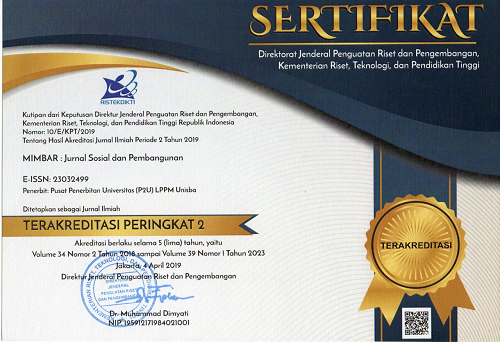Construction Of A Performance Assessment Model For Zakat Management Institutions
Abstract
The objective of the research is to examine the performance evaluation using Balanced Scorecard model. The research is conducted due to a big gap existing between zakat (alms and religious tax in Islam) with its potential earn of as much as 217 trillion rupiahs and the realization of the collected zakat fund that is only reached for three trillion. This indicates that the performance of zakat management organizations in collecting the zakat is still very low. On the other hand, the quantity and the quality of zakat management organizations have to be improved. This means the performance evaluation model as a tool to evaluate performance is needed. The model construct is making a performance evaluation model that can be implemented to zakat management organizations. The organizational performance with Balanced Scorecard evaluation model will be effective if it is supported by three aspects, namely: PI, BO and TQM. This research uses explanatory method and data analysis tool of SEM/PLS. Data collecting technique are questionnaires, interviews and documentation. The result of this research shows that PI, BO and TQM simultaneously and partially gives a significant effect on organizational performance.
Keywords
Full Text:
PDFReferences
Apfelthaler Gerard, Hellen J Muller and Robert R Rehder. (2002). Corporate Global Culture as
Competitive Advantage: Learning from Germany and Japan in Alabama and Austria. Journal of World Business (JWB). P. 37.108
Budi Budiman,(2002), Potensi Dana ZIS Sebagai Instrumen Ekonomi Islam dari Teori dan
Implementasi Manajemen. Makalah disajikan dalam Simposium Nasional Sistem
Nasional Ekonomi Islam, Yogyakarta. Hal. 16
Christian Herdinata. (2008). Good Corporate Governance Vs Bad Corporate Governance :
Pemenuhan Kepentingan Antara Para Pemegang Saham Mayoritas dan Pemegang Saham Minoritas. Makalah ini disajikan dalam The 2nd National Conference UKWMS Surabaya, 6 September 2008. P.14-15
Committee of Sponsoring Organization (COSO) of The Treadway Commision (2004).
Enterprise Risk Management – Integrated Framework: Executive Summary. COSO. September 2004. P. 13
Flamholtz, Eric. (2001). Corporate Culture and The Bottom Line, European Management
Journal Vol. 19, No. 3, 2001 Published by Elsevier Science Ltd. All rights reserved Printed in Great Britain 0263-2373/01. pp. 266–275
Hoque Zahirul. (2003). Total Quality Management and The Balanced Scorecard Approach: A
Critical Analysis of Their Potential Relationship and Dirrections for Research. Journal Critical Perspective on Accounting.p.43
Ikatan Akuntan Indonesia. (2012). Standar Akuntansi Keuangan. Penerbit Salemba Empat.
Jakarta p.319-2
Kaplan. Robert and David P Norton. (1996). The Strategy Focused Organization. Harvard
Business School Press. Boston. Massachusetts.p. 102
………(1996),.Menerapkan Strategi Menjadi Aksi: Balanced Scorecard. Dialihbahasakan oleh
Peter R Yosi Pasla. Penerbit Erlangga. Jakarta
........... and Robbin Cooper. (1998). Cost and Effect: Using Integrated Cost Systems to Drive
Profitability and Performance. Harvard Business School Press. Boston
Kreitner. Robert & Kinichi Angelo. (2008). Organization Theory and The New Public
Administration. Boston. Allyn and Bacon Inc. 72
Morgan, Robert M and Shelby Hunt. (1994). The Commitment Trust Theory ofRelationship
Marketing. Journal of Marketing 58:20-38
Pepper. Don and Rogers Martha. (2004). Managing Customer Relationships. New Jersey; John
Wiley & Sons, Inc.
Robbin, Stephen P. (2010). Organization Theory, Structure, Design and Application. Seventh
Edition, Prentice Hall International. Inc. United of America. P. 210
Rohm. Howard. (2004), Improve Public Sector Result With A Balanced Scorecard: Nine Steps
to Success. http//www.balancedscorecard.org.
Samdin, (2002). Motivasi Berzakat: Kajian Manfaat dan Peranan Kelembagaan,. Makalah
disajikan dalam Simposium Nasional Ekonomi Islam, Yogyakarta. H.19
.............(2002). “Pengembangan Manajemen Bazis ”. Makalah disajikan dalam Simposium
Nasional Ekonomi Islam, Yogyakarta. H.23
Shamdasni, Prem N and Audrey Balakrishnan. (2000). Determinants of Relationship
Quality and Loyalty in Personalized Services. Asia Pacific Journal of Management. 17:399-22
Sirdeshmukh, Deepak; Jaddig Singh; Berry Sabol. (2002). Customer Trust, Value and
Loyalty in Relational Exchanges. Journal of Marketing, 66:15-37. Chicago.
Sri Fadilah. (2012). Membangun Kepercayaan Konsumen: Faktor Penting Pada Lembaga
Amil Zakat di Indonesia. Makalah disajikan pada SNAPP 2015. LPPM Unisba. Bandung. H. 8.
…………..(2012). Analisis Pengaruh Implementasi Pengendalian Intern dan Total Quality
Management Terhadap Kinerja Organisasi Disajikan pada SNAB 2012 Universitas
Widyatama. Bandung. H.12
.................(2011). Pengaruh Implementasi Pengendalian Intern dan Total Quality
Management Terhadap Penerapan Good Governance. Disajikan pada SNA 14 di
Universitas Syiah Kuala Nangroe Aceh Darussalam. H.11
Tenner, Arthur R and Detoro Irving J. (2008). Total Quality Management. Adison-Wesley
publishing company. USA.p.32
Undang-Undang No 23 Tahun (2011) tentang Pengelolaan Zakat di Indonesia
Zabid, Abdul Rahid, Murali Sambasivam and Juliana Johari. (2003). The Influence of Corporate
Culture and Organization Commitment on Performance. The Journal of Management Development N0.8. 56.
DOI: https://doi.org/10.29313/mimbar.v32i2.1934
Refbacks
- There are currently no refbacks.
MIMBAR : Jurnal Sosial dan Pembangunan is licensed under Creative Commons Attribution-NonCommercial-ShareAlike 4.0 International License.















